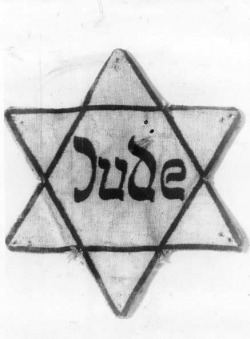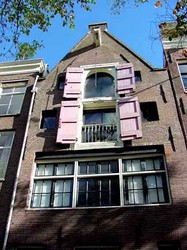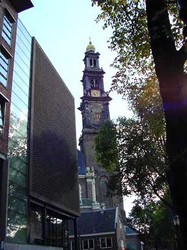The Diary of Anne Frank

In order to fully understand what happens to the Frank family, students must have a good understanding of historical context. During this unit, we will have the opportunity to speak with real witnesses of the Holocaust through video conference, watch age appropriate videos that help students see historical and primary documents, and participate in a story path of Prisengracht (the street of the Secret Annexe) in order to learn the reality of this situation in order to prevent something like this from happening again. The version of the diary that is read in class actually is a reader's theater. Also, we look at the role of victims and bystanders and compare these roles to real life situations they can relate to presently.
REQUIRED Writers Notebook Entry
On a ½ sheet respond to the following poem by answering two questions:
1.) What do you think motivated Pastor Martin Niemoller to write this piece?
2.) Describe a time in which you wanted to speak out but did not. What motivated you to stay quiet?
-OR-
Describe a time in which you chose to speak out for what is right. What motivated you to speak out?
First they came for the Jews
By Pastor Martin Niemoller
First they came for the communists, and I did not speak out--
because I was not a communist;
Then they came for the socialists, and I did not speak out--
because I was not a socialist;
Then they came for the trade unionists, and I did not speak out--
because I was not a trade unionist;
Then they came for the Jews, and I did not speak out--
because I was not a Jew;
Then they came for me--
and there was no one left to speak out for me.
REQUIRED Writers Notebook Entry
On a ½ sheet respond to the following poem by answering two questions:
1.) What do you think motivated Pastor Martin Niemoller to write this piece?
2.) Describe a time in which you wanted to speak out but did not. What motivated you to stay quiet?
-OR-
Describe a time in which you chose to speak out for what is right. What motivated you to speak out?
First they came for the Jews
By Pastor Martin Niemoller
First they came for the communists, and I did not speak out--
because I was not a communist;
Then they came for the socialists, and I did not speak out--
because I was not a socialist;
Then they came for the trade unionists, and I did not speak out--
because I was not a trade unionist;
Then they came for the Jews, and I did not speak out--
because I was not a Jew;
Then they came for me--
and there was no one left to speak out for me.
| anne_frank_kwl.doc |
Allegory and Picture Books
In order to get a better understanding of the Holocaust, students have been practicing making inferences by looking at character's actions, making judgements about the character, and finding examples of times they feel empathy for a character. This was initially modeled using Eve Bunting's allegory of the Holocaust entitled The Terrible Things. Allegory is a story that on the surface seems to be about one thing but is really about another. For example, The Terrible Things on the surface seems to be a story about forest creatures but is really a Holocaust story with the different animals representing different groups of people affected by the Holocaust and The Terrible Thing being the SS, Einsatzgruppe, or the Nazi's, depending on your interpretation. Afterwards, the student's got into small groups and chose one picture book related to the Holocaust, World War II or Japanese Internment, practicing the exact same skill. Book options are listed below:
**Erika's Story
**Rose Blanche
**Let the Celebration Begin!
**The Butterfly
**Baseball Saved Us
**Hiroshima No Pika
**Faithful Elephants
**The Number on my Grandfather's Arm
**How I Learned Geography
**So Far From the Sea
**Boxes for Katje
After the small groups read and completed the activity, student's got into small groups and discussed their stories, looking for similarities and differences between their personal story and the others read in class.
**Erika's Story
**Rose Blanche
**Let the Celebration Begin!
**The Butterfly
**Baseball Saved Us
**Hiroshima No Pika
**Faithful Elephants
**The Number on my Grandfather's Arm
**How I Learned Geography
**So Far From the Sea
**Boxes for Katje
After the small groups read and completed the activity, student's got into small groups and discussed their stories, looking for similarities and differences between their personal story and the others read in class.
| anne_frank_inferring_interactive_read_aloud_worksheets.doc |
Anne Frank Story Path

The front of the Anne Frank House
A Story Path allows participants to investigate a real setting of a story by creating a historically fictional version of this place. Students were shown images of Prisengracht, the street in which Anne Frank, her family, and two other families went into hiding. Taking notes about the structures and types of buildings, student's were put in small groups in order to create "their business,'" adding them to our street in class. From there, we took their pictures off a previous project and created fictional stories about their business.' The intention is to help student's realize that while Anne Frank was living her unusual life in hiding, the rest of the world was still bustling and affected by the war. Simultaneously, it teaches characterization and setting in a unique way.
These are some sites we checked out in order to fill out the sheet below. These images helped kids see what it was really like:
The Anne Frank House -click on the links entitled The Hiding Place, The Helpers Together, and The Movable Bookshelf.
The only real footage of Anne Frank in the Secret Annexe.
I also read from a site; however, I am going to post the information I read and not the link because the site was screened for inappropriate content. Below is all the pictures the site refers to in the descriptions. Students were looking for business' and establishments that were really on Prisengracht in order to choose their business for the story path. This information was very useful for their decision.
The building at number 263 Prinsengracht in Amsterdam, popularly known as the Anne Frank House, is not the place where Anne was born, nor even the home where the Frank family lived after Otto Frank moved from Frankfurt, Germany to the Netherlands in 1933. Rather, it is a four-story merchant's house, built in 1635, where Anne's father, Otto Frank, operated two businesses: one which produced pectin to be used in making jelly and other products, and the other which produced herbs and spices for making sausage.
The building is a typical Amsterdam four-story canal house which faces the Prinsengracht, one of Amsterdam's most beautiful canals. Behind the house at 263 Prinsengracht street is a separate building that was constructed at a later time: a four-story annex with an attic. The annex is separated from the main house by a space that is about 12 feet wide, but it is connected to the main house by passageways.
On the left in the photograph above, there is an Italian restaurant which advertises on a sign in English: "Two steps down, Best Coffee in Town." In front of the Anne Frank House, but not shown in the photograph, are some tables and benches where customers of the restaurant can eat their take-out food.
The photograph above was taken from the street in front of the main house at 263 Prinsengracht. There is no fence or barrier separating the street from the canal, so I had to be careful not to step back too far to take a photo of the house, for fear of falling into the water.
The annex where Anne and her family hid from the Nazis is open to the public on every day of the year, except on Yom Kippur, a Jewish holiday which falls on a different date each year. Visiting hours are 9 a.m. to 9 p.m. between April and August. From September to March, the house is open from 9 a.m. to 7 p.m. The entrance to the house is through a new modern building at 267 Prinsengracht, two doors up the street. In this building is a bookshop and a cafeteria that tourists can visit at the end of their tour of the exhibits.
The Anne Frank house is located only a few yards from the Westerkerk, a Protestant church with a clock tower which Anne mentioned in the following entry in her diary:
Father, Mother and Margot still can't get used to the chiming of the Westertoren clock, which tells us the time every quarter of an hour. Not me, I liked it from the start; it sounds so reassuring, especially at night.
The photograph below shows the famous church tower. On the left is the modern building at 267 Prinsengracht; the windows of the cafeteria on the first floor overlook the church. The low building between the church and the cafeteria is, believe or not, a bar. That's right, a bar adjoins the most famous church in Amsterdam.
If you were absent, you will have to join a group to fulfill the characterization component.
These are some sites we checked out in order to fill out the sheet below. These images helped kids see what it was really like:
The Anne Frank House -click on the links entitled The Hiding Place, The Helpers Together, and The Movable Bookshelf.
The only real footage of Anne Frank in the Secret Annexe.
I also read from a site; however, I am going to post the information I read and not the link because the site was screened for inappropriate content. Below is all the pictures the site refers to in the descriptions. Students were looking for business' and establishments that were really on Prisengracht in order to choose their business for the story path. This information was very useful for their decision.
The building at number 263 Prinsengracht in Amsterdam, popularly known as the Anne Frank House, is not the place where Anne was born, nor even the home where the Frank family lived after Otto Frank moved from Frankfurt, Germany to the Netherlands in 1933. Rather, it is a four-story merchant's house, built in 1635, where Anne's father, Otto Frank, operated two businesses: one which produced pectin to be used in making jelly and other products, and the other which produced herbs and spices for making sausage.
The building is a typical Amsterdam four-story canal house which faces the Prinsengracht, one of Amsterdam's most beautiful canals. Behind the house at 263 Prinsengracht street is a separate building that was constructed at a later time: a four-story annex with an attic. The annex is separated from the main house by a space that is about 12 feet wide, but it is connected to the main house by passageways.
On the left in the photograph above, there is an Italian restaurant which advertises on a sign in English: "Two steps down, Best Coffee in Town." In front of the Anne Frank House, but not shown in the photograph, are some tables and benches where customers of the restaurant can eat their take-out food.
The photograph above was taken from the street in front of the main house at 263 Prinsengracht. There is no fence or barrier separating the street from the canal, so I had to be careful not to step back too far to take a photo of the house, for fear of falling into the water.
The annex where Anne and her family hid from the Nazis is open to the public on every day of the year, except on Yom Kippur, a Jewish holiday which falls on a different date each year. Visiting hours are 9 a.m. to 9 p.m. between April and August. From September to March, the house is open from 9 a.m. to 7 p.m. The entrance to the house is through a new modern building at 267 Prinsengracht, two doors up the street. In this building is a bookshop and a cafeteria that tourists can visit at the end of their tour of the exhibits.
The Anne Frank house is located only a few yards from the Westerkerk, a Protestant church with a clock tower which Anne mentioned in the following entry in her diary:
Father, Mother and Margot still can't get used to the chiming of the Westertoren clock, which tells us the time every quarter of an hour. Not me, I liked it from the start; it sounds so reassuring, especially at night.
The photograph below shows the famous church tower. On the left is the modern building at 267 Prinsengracht; the windows of the cafeteria on the first floor overlook the church. The low building between the church and the cafeteria is, believe or not, a bar. That's right, a bar adjoins the most famous church in Amsterdam.
If you were absent, you will have to join a group to fulfill the characterization component.
| anne_frank_story_path.doc |
Survivors

Gerda Weissmann
We have the opportunity to meet via videoconference two different people involved during World War II and the Holocaust. The first meeting takes place on November 24th. I am going to attempt to video this and upload our conversations onto the website. "Charles" is a person who lived in Europe during World War II and had a best friend who was taken into the concentration camps and survived. This gives him two unique perspectives of life during the war. Afterwards, he was inspired to become a Holocaust expert, travelling to multiple ghettoes, concentration camps, such as Auschwitz, and interviewing numerous Holocaust survivors. Also, he is a retired middle and high school social studies teacher who can help answer questions students may have regarding historical context in a way that is interpretative to the middle school age group,
The second takes place with Gerda Weissmann Klein, a very famous Holocaust survivor, on December 10th. Several schools will be video conferencing with her simultaneously. We will be learning about her experience through a TeachingTolerance.org video series prior to the videoconference. For more information about Gerda Weissmann, check out the Gerda and Kurt Klein Foundation website, the US Holocaust Memorial Museum site, or the Teaching Tolerance site for more information.
After Winter Break, we will be partaking in a food drive as part of a challenge sponsored by the Gerda and Kurt Klein Foundation. The proceeds will go to local food banks; however, we will be documenting our experience in an online blog. Stay tuned for the link to the blog.
The second takes place with Gerda Weissmann Klein, a very famous Holocaust survivor, on December 10th. Several schools will be video conferencing with her simultaneously. We will be learning about her experience through a TeachingTolerance.org video series prior to the videoconference. For more information about Gerda Weissmann, check out the Gerda and Kurt Klein Foundation website, the US Holocaust Memorial Museum site, or the Teaching Tolerance site for more information.
After Winter Break, we will be partaking in a food drive as part of a challenge sponsored by the Gerda and Kurt Klein Foundation. The proceeds will go to local food banks; however, we will be documenting our experience in an online blog. Stay tuned for the link to the blog.
| anne_frank_survivor_questions.doc |




